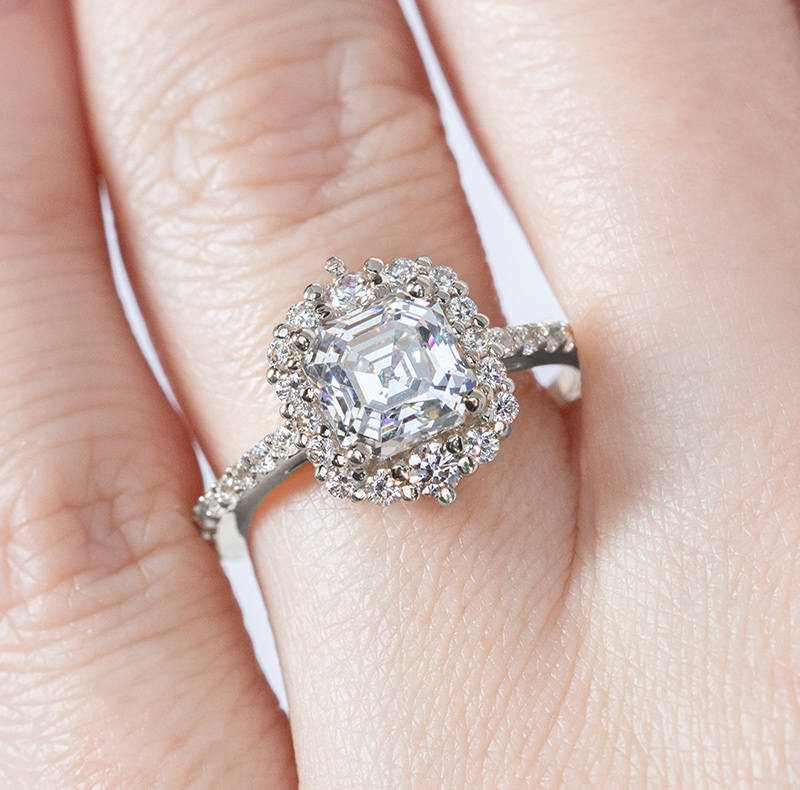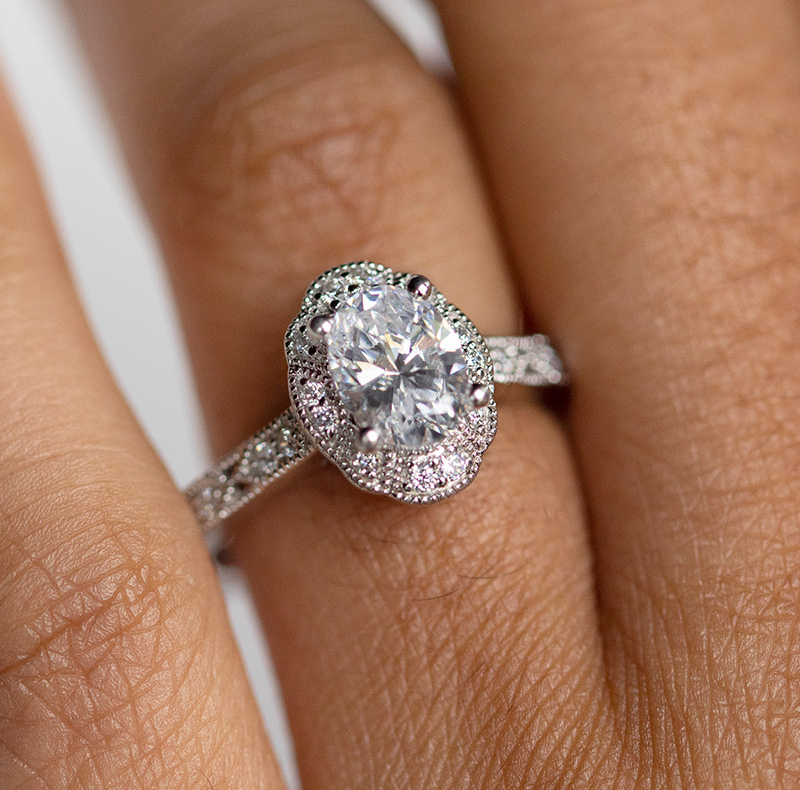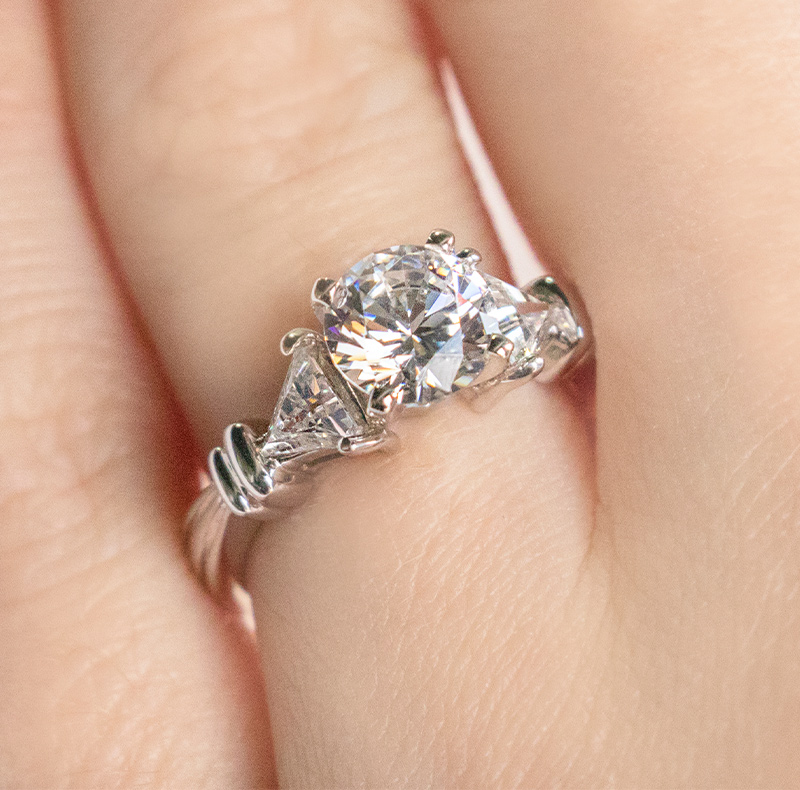A Guide to Platinum Ring Settings
November 12th, 2020 / Lindsay Kazan
Are you looking for an engagement ring that’s as durable as it is gorgeous? Do you want a setting that magnifies the natural beauty of your dazzling center stone? If yes, let us introduce you to platinum, a rare and valuable precious metal that is growing increasingly popular on the fine jewelry scene.

What is Platinum?
One of the purest precious metals that you can buy, platinum is a naturally white mineral that doesn’t need to be combined with other substances to achieve its coveted cool hue. To be considered platinum, a jewelry piece must consist of at least 95% pure platinum with the remaining 5% containing other alloys.
Why Choose a Platinum Engagement Ring Setting?
As with anything, there are pros and cons to choosing platinum engagement rings. There are other metals you might be drawn to: maybe you’re deciding between a titanium vs platinum ring setting. Nonetheless if you’re interested in platinum engagement rings, here’s what you need to know to make an informed decision.
Platinum Cons:
-
Price: The best of the best comes at a price and platinum jewelry pieces are no different. You can expect to spend more on platinum rings than you would on white gold engagement rings even though the two are nearly identical in appearance.Long’s Fine Jewelers explains the price discrepancy between the two as “One of the biggest selling points of white gold over platinum is cost. Platinum will almost always be more expensive than white gold because it is 30 times more rare and mined much less than gold. To be more specific, 2,700 tons of gold are mined per year compared to 80 tons of platinum.” In addition, other factors such as density come into play because some precious metals are priced by weight. Platinum is also less malleable than other metals making it a more difficult material to work with so the cost of labor is another factor that can amp up the overall price.
-
Difficult to Resize: Resizing a platinum ring wedding band tends to be tricky because platinum requires a higher heating point than other metals making repair more labor-intensive and time-consuming. In addition, heat travels quickly through platinum which increases the chance of damaging the gemstone that adorns your ring and can cause the band of the ring to warp during the process.
-
Maintenance and Care: Unlike other metals used in fine jewelry, platinum does not fade or tarnish over time. However, this durable metal does require some TLC to keep it looking its best and platinum pieces should be removed when partaking in certain activities to avoid damage. To clean, use either a gentle cleaner made specifically for platinum or soak the piece in a mild mix of soap and warm water. Be sure to never submerge your rings or fine jewelry in cleaning solutions as the harsh chemicals can cause damage to the center stone.
Similar to rose gold, platinum will develop something called patina over time, which results in a change in surface texture that gives off a frosted look. Luckily, it’s up to you if you like the look of the patina and it can be easily removed with a quick polishing session.
Which Settings Look Best in Platinum?
Some engagement ring settings pair amazingly with platinum’s clean white hue. If you really want your diamond engagement ring to pop try one of these captivating styles.

Solitaire Engagement Ring
First popularized by famous jeweler Tiffany & Co., a solitaire setting features a single diamond gemstone fixed upon a metal band that can be set with pave diamonds or be completely sleek with no additional diamonds or gemstones. A solitaire engagement ring setting is a timeless engagement ring style that looks great with all diamond shape options and metal types but is especially captivating when combined with platinum’s icy hue.

Halo Engagement Ring
If you’re looking for an engagement ring that can be admired from across the room go with a glamourous halo setting. In a halo setting, the center diamond is surrounded by a circle of smaller diamonds referred to as accent stones to create the illusion of an extra large diamond. And the sparkle doesn’t have to stop there, pair a halo setting with a pave set platinum band to take your piece to the next level or keep it sleek with a smooth metal band.

Vintage Engagement Ring
Known for their fancy filigree, Art Deco vibes and colorful gemstones, a vintage engagement ring design is a popular choice among couples. These antique styles also happen to look great in platinum ring settings. Bright turquoise, amethyst, opal and blue enamel are striking in contrast against platinum’s pale tone. Or, go for an Edwardian era-inspired piece with a monochromatic design paired with intricate scrollwork for a forever adornment that’s truly unique.

Three Stone Engagement Ring
Romantic by design, a three stone ring represents a couple’s past, present and future. Rings in this type of setting feature a glimmering center stone and two side stones, either diamonds or colorful gemstones, to create a low profile style similar to the solitaire but with even more sparkle. Combine a three stone engagement ring with an accented platinum wedding band for a look that radiates classic beauty.
Bali Accented Oval Cut
No matter your favorite diamond shape, it can go with a platinum setting. However, one thing to keep in mind when choosing your diamond is color. Because platinum is so lustrous it’s important to choose a diamond that can live up to the sparkle without appearing yellow or dark by comparison.
Fancy diamond shapes – radiant, pear, marquise, oval, Asscher, heart, emerald and princess cut diamonds – are more prone to showing color than classic cuts such as a round diamond. If one of these shapes strikes your fancy be sure to choose a stone with an H or I color for the most platinum-friendly result.
Other shapes such as round brilliant and cushion cut diamonds are able to mask any unwanted color thanks to their brightness and brilliance. However, as a rule of thumb, it is still recommended to purchase a stone with a color grade of H or higher for the most aesthetically pleasing results.

Where Can I Buy a Platinum Ring?
Whether you prefer to make a visit to local jewelry stores or choose to surf the web, platinum engagement rings and fine jewelry pieces are widely available. Whatever you decide, don’t be afraid to shop around before committing to your forever adornment and enjoy your new platinum piece that will shine beautifully for years to come.
*Here at Diamond Nexus, we strive to provide valuable information while being clear and honest about our products. The Nexus Diamond™ alternative is a patented lab created diamond simulate that, among all simulants, most closely imitates the look, weight and wear of a diamond, with two exceptions – it is absolutely perfect in every way, and it costs significantly less. Price points and environmental facts expressed in this blog were taken from popular online retailers and may vary. Learn more about the environmental impact of mining by visiting our blog.

